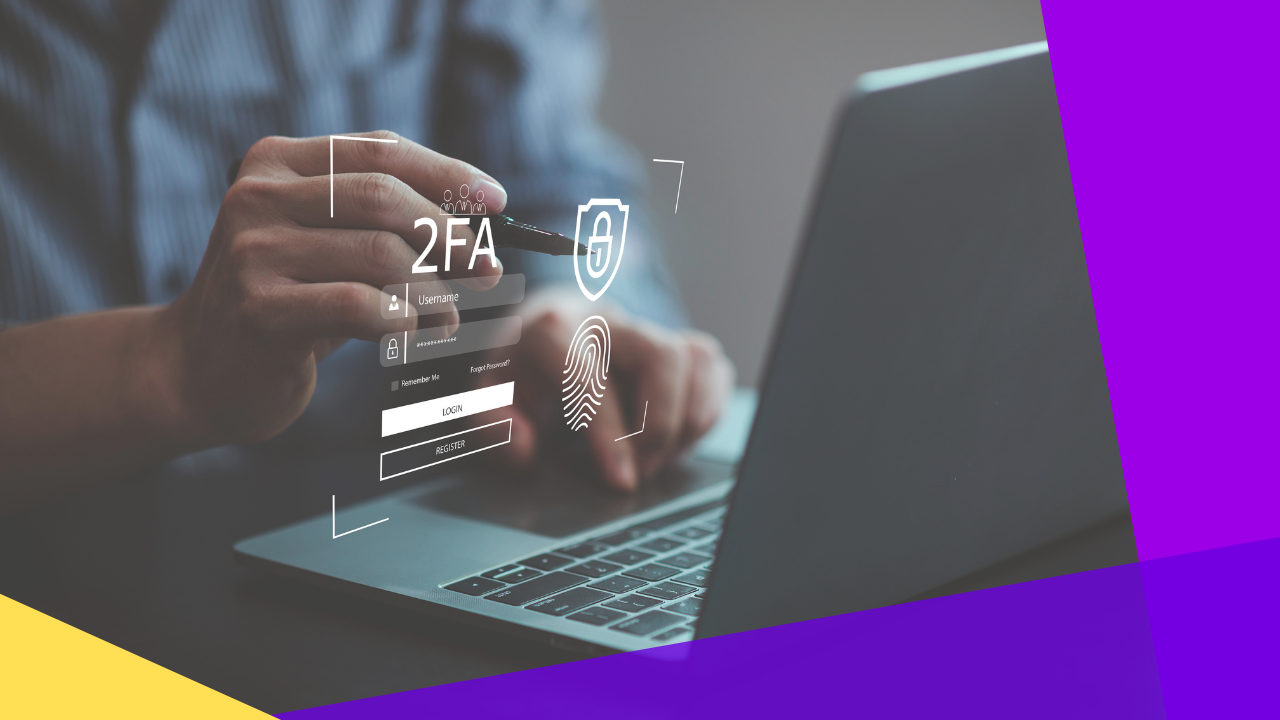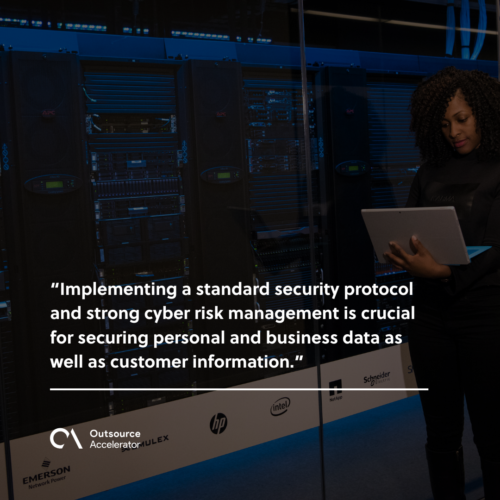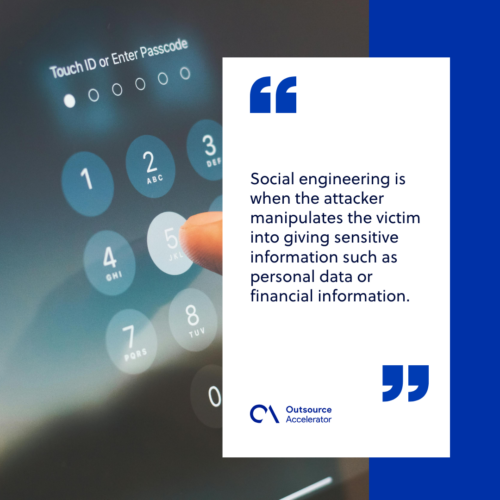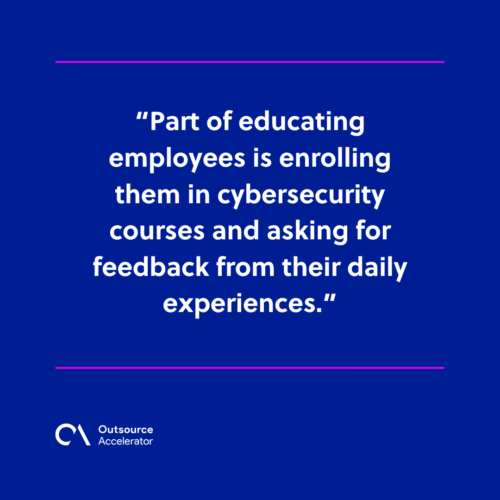How cybersecurity threats are putting online businesses at risk

This article is a submission by 20four7VA. 20four7VA is a trusted remote hiring company specializing in cost-effective, end-to-end offshore contract staffing solutions to all businesses worldwide.
Small businesses are major targets of cyberattacks. Accenture‘s recent study confirmed that 43% of cyber attacks target small businesses. Even more shocking is that only 14% of these small businesses are making conscious efforts to counter these constant threats.
With so many expenses to consider, cybersecurity is near the bottom of the ladder for many small business owners.
This lack of attention leads to more vulnerabilities, and more vulnerabilities lead to higher risk of exposure to online threats.
Unfortunately, only a few online business owners know how to protect themselves from hackers and understand the consequences of not having cybersecurity. But if you want longevity for your business, investing in cybersecurity measures is critical from the get-go.
What is cybersecurity?
In the most basic sense, cybersecurity is any practice that protects a business from digital threats.
Security measures can be simple, such as creating strong passwords, turning on your firewall, and keeping private information safe. More elaborate steps include investing in cloud and operational security, alongside educating staff on cybersecurity best practices.
Any step taken to protect the company’s information and reputation puts it farther away from the reach of cybercriminals.
Having robust cybersecurity measures cannot be overstated. Many small business owners believe they are too small or insignificant to be targeted, but this can lead to devastating consequences down the road.

Implementing a standard security protocol and strong cyber risk management is crucial for securing personal and business data as well as customer information. Also, clients are more likely to interact with businesses that maintain good cyber hygiene.
Prioritizing cybersecurity for small businesses is not just about protecting assets but also ensuring long-term business sustainability.
3 biggest cybersecurity threats
Cybersecurity threats can pose significant financial and reputation damage to your business if not prevented or addressed on time. According to BusinessDasher, SMBs (small and medium-sized businesses) lose around $25,000 because of cyber attacks.
Aside from grave financial losses, hackers can ruin the brand image or use company data to target your customer base. This can break the customer’s trust in your product or service, leading to a loss of loyalty and potentially causing long-term damage to your overall image.
Customers who feel unsafe with your brand may switch to competitors, and word of mouth can spread quickly, amplifying the damage to your already tarnished reputation.
The damage to your brand image can extend beyond just customers to business partners, investors, and employees, as they may question your ability to safeguard their information.
Rebuilding customer trust after a breach often takes many years, and sometimes, a company may never fully recover its good standing in the market.
In 2024, cybersecurity threats are becoming more complex and hostile. In a study done by Boardroom Cybersecurity Report 2024, ransomware cybersecurity threats will cost its victims $265 billion USD by 2031.
On the other hand, social engineering and supply chain vulnerabilities exploit human and third-party weaknesses. These big threats also put a huge strain on larger businesses.
These are the three big cybersecurity threats to watch out for in 2024:
Ransomware
Ransomware attacks encrypt private information in exchange for a ransom. The decryption key will be given when the ransom is paid.
Criminals can choose to attack your customers’ or investors’ information and extort a large amount of money from them. This attack has many variants, each posing heavier damage to its victim.
Even large companies are not safe from cyber attacks. In early 2022, Nvidia was attacked by a ransomware group.
The group leaked passwords and threatened to leak source codes and other crucial information. This attack compromised Nvidia’s operations for almost two days.
Social engineering
Social engineering is when the attacker manipulates the victim into giving sensitive information such as personal data or financial information. What’s special about this cyber attack is it exploits human psychology rather than the safeguards built around the data.
Phishing is the most common type of social engineering. This involves “Phishers” who can attack their victims via SMS or email.
In 2023, Okta, an IT service management company, had customers compromised by an elaborate social engineering scheme. The attackers impersonated Okta employees to steal customer’s access and credentials.

Supply chain attacks
Unlike ransomware and social engineering, supply chain attacks the manufacturing and distribution aspects of the business. Attackers usually target third-party service providers to infiltrate the customer’s personal information.
These attacks can cause service delays or interruptions in product delivery, potentially leading to poor customer experience or lessened customer trust.
In 2017, Equifax, a credit bureau agency was breached because it failed to address a particular security issue. The breach affected almost 147 million customers.
This is a firm reminder for businesses to update patches in their software supply chain.
The countermeasures you need to take now
Small businesses should have cybersecurity countermeasures to protect themselves and their customers from future threats.
While placing countermeasures may take time, simple steps like using strong passwords, enabling two-factor authentication, and keeping software up to date make a huge difference in protecting the business from attackers.
Every small measure adds up. By taking basic precautions, small businesses can be safer and less vulnerable.
These are some countermeasures you need to take now!
Have good cyber hygiene
Good cyber hygiene ensures that your system is safe from any online threats and has the necessary countermeasures for potential attacks. Good cyber hygiene starts with installing reliable and updated antivirus software to protect against malware and other threats.
Multi-factor Authentication
Multi-factor authentication (MFA) adds an extra layer of security to your accounts. MFA requires users to provide two or more forms of identification, such as a password and a code sent to their phone, preventing attackers from gaining unauthorized access.
This added layer of protection reduces the risk of cybercriminals bypassing security measures and discourages pending threats.
Strong passwords
‘123456’ or ‘Password’ is never a strong password. A strong password is long, unique, and a combination of uppercase and lowercase letters, numbers, and special characters.
A good password should also be different for each account to prevent one compromised password from granting access to multiple accounts. Leading authorities have varying opinions on the frequency of changing passwords.
Some say passwords should be changed every 90 days, while others suggest updates can be done once every few months.
Regular backup
If important files or systems are compromised, a backup allows you to restore your data quickly and minimize downtime. Small businesses should make it a habit to backup financial records, customer information, and operational files more often.
Cloud-based backups or off-site storage solutions are ideal because it’s easier to access and protect you from identity theft. Regularly testing the reliability of your backups is also essential to avoid massive future financial losses and reputation damage.
Update your hardware, software, and firmware
Software patch updates are provided by developers to fix security flaws or bugs that may affect your smooth workflow. Firmware updates are similar to software updates, but apply to the low-level software embedded in your hardware, like routers or motherboards.
This update is done to improve your device’s performance.
Replacing outdated devices maintains a secure infrastructure and assures compatibility with the latest software patches. Remember, outdated hardware is a target of data breaches and exploitation. It’s better to invest in hardware now than experience the consequences later on.
Train your employees about cybersecurity
Small businesses need to involve their team in cybersecurity. Employees are the first line of defense against cyber threats, so they need to be aware of the attacks that they might encounter.
Having a set of guidelines and protocols in place ensures that everyone is on the same page in protecting company data.
Part of educating employees is enrolling them in cybersecurity courses and asking for feedback from their daily experiences. These courses can cover key topics- email management, avoiding phishing scams, software patch updates, etc.
Gathering feedback allows businesses to understand where employees may be struggling or where additional training might be needed.

Protecting against cybersecurity threats
Cybersecurity is not a one-time effort. It’s an ongoing process of adapting to the trends and improving existing efforts. As cyber threats become more elaborate, businesses must keep track of cybersecurity trends and embrace learning.
To save time and ensure maximum security, small businesses might want to consider outsourcing an IT specialist for their team. A remote IT specialist can monitor systems for vulnerabilities, implement security measures, and tailor best cybersecurity practices for the whole team.
With their expertise, you can ensure that your business is better prepared to prevent and respond to potential cyberattacks, providing long-term guaranteed security.







 Independent
Independent




